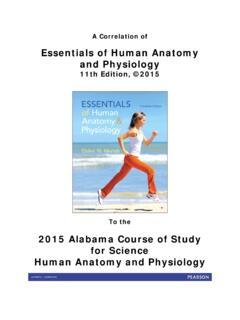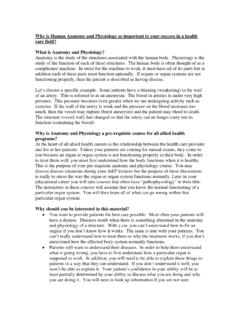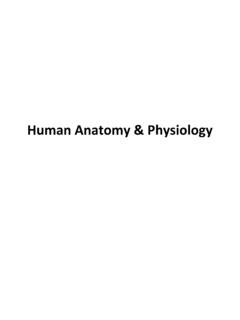Transcription of Human Anatomy & Physiology - testbanktop.com
1 Test BankHuman Anatomy & PhysiologySeventh EditionElaine N. MariebKatja HoehnWayne Seifert Brookhaven CollegeBert AtsmaUnion County CollegeSan Francisco Boston New YorkCape Town Hong Kong London Madrid Mexico CityMontreal Munich Paris Singapore Sydney Tokyo TorontoEditor-in-Chief: Serena BeauparlantEditorial Assistant: Alex StreczynManaging Editor: Wendy EarlProduction Editor: Leslie AustinComposition: Tamarack SoftwareSenior Manufacturing Buyer: Stacey WeinbergerExecutive Marketing Manager: Lauren HarpCover Designer: Frances BacaCopyright 2007 by Pearson Education, Inc., publishing as Pearson Benjamin Cummings, San Francisco,CA 94111. All rights reserved. Printed in the United States of America. This publication is protected byCopyright and permission should be obtained from the publisher prior to any prohibited reproduction,storage in a retrieval system, or transmission in any form or by any means, electronic, mechanical, photo-copying, recording, or likewise.
2 For information regarding permission(s), write to: Pearson Education, Inc.,Rights and Permissions of the designations used by manufacturers and sellers to distinguish their products are claimed astrademarks. Where those designations appear in this book, and the publisher was aware of a trademarkclaim, the designations have been printed in initial caps or all : 0-8053-7378-02 3 4 5 6 7 8 9 10 TCS 10 09 08 07 Test Bank was developed to accompany Human Anatomy & Physiology , Seventh Edition,by Elaine N. Marieb and Katja Hoehn. Each chapter contains a variety of questions, including: Matching Questions True/False Questions Multiple-Choice Questions Fill-in-the-Blank/Short Answer Questions Clinical QuestionsSince it is often difficult to measure student understanding of conceptual ideas, especially inphysiology, emphasis is placed on the proper design of multiple-choice questions. Becausemultiple-choice questions test comprehension as well as recall, a large number of these questionsare provided.
3 Additionally, objective questions lend themselves well to machine scoring, whichis often necessary with large each question in this Test Bank, the following information is provided:Answer:Correct answer. The essay questions include short answers that may be expandedupon by the instructor or :Level of difficulty. Noted as 1 (relatively easy; requires a thorough knowledge ofvocabulary), 2 (harder; requires greater in-depth understanding of vocabularyand basic concepts), and 3 (hard; requires a thorough understanding of vocabu-lary and concepts as well as analysis of this information).Page Ref: Reference to the page(s) where the vocabulary or concept can be found, and mayinclude relevant figure and table Test Bank is intended as a complete question source to accompany the text, but it canalso be used to supplement any existing questions an instructor may already be using. The TestBank is formatted so that an instructor can cut and paste questions for preparation of an interactive Macintosh and Windows CD-ROM version of this Test Bank is available, whichwill allow you to easily alter the questions provided or add new questions to fit your class.
4 Visitthe Addison Wesley/Benjamin Cummings catalog page to download the electronic version of thisprinted Test Bank and other available instructor supplements at testing is an integral part of any course, and science courses in particular are an idealarena to explore logical thought processes, we hope this Test Bank will serve as a nucleus fordeveloping critical thinking in students and will enhance the learning experience for both studentsand are always looking for new questions to add to this Test Bank, so please feel free tosuggest questions you would like to see added to the next Seifert, Brookhaven CollegeBert Atsma, Union City CollegeAnatomy and PhysiologyBenjamin Cummings Science1301 Sansome StreetSan Francisco, CA 94111 Contents Chapter 1 The Human Body: An Orientation 1 Chapter 2 Chemistry Comes Alive 20 Chapter 3 Cells: The Living Units 43 Chapter 4 Tissue: The Living Fabric 64 Chapter 5 The Integumentary System 83 Chapter 6 Bones and Skeletal Tissue 105 Chapter 7 The Skeleton 124 Chapter 8 Joints 143 Chapter 9 Muscles and Muscle Tissue 160 Chapter 10 The Muscular System 184 Chapter 11 Fundamentals of the Nervous System and Nervous Tissue 203 Chapter 12 The Central Nervous System 222 Chapter 13 The Peripheral Nervous System and Reflex Activity 249 Chapter 14 The Autonomic Nervous System 269 Chapter 15 The Special Senses 287 Chapter 16 The Endocrine System 311 Chapter 17 Blood 333 Chapter 18 The Cardiovascular System: The Heart 352 Chapter 19 The Cardiovascular System: Blood Vessels 372 Chapter 20 The Lymphatic System 395 Chapter 21 The Immune System.
5 Innate and Adaptive Body Defenses 410 Chapter 22 The Respiratory System 433 Chapter 23 The Digestive System 456 Chapter 24 Nutrition, Metabolism, and Body Temperature Regulation 481 Chapter 25 The Urinary System 504 Chapter 26 Fluid, Electrolyte, and Acid-Base Balance 525 Chapter 27 The Reproductive System 543 Chapter 28 Pregnancy and Human Development 567 Chapter 29 Heredity 585 Chapter 1 The Human Body: An OrientationMatching QuestionsFigure Figure , match the following cavities:1) Thoracic : CDiff: 1 Page Ref: 15-17; Fig. ) Cranial : ADiff: 1 Page Ref: 15-17; Fig. Test Bank for Human Anatomy & Physiology3) Abdominal : DDiff: 1 Page Ref: 15-17; Fig. ) Vertebral : BDiff: 1 Page Ref: 15-17; Fig. Figure , match the following regions:5) Umbilical : CDiff: 1 Page Ref: 18; Fig. ) Right : BDiff: 1 Page Ref: 18; Fig. 1 The Human Body: An Orientation 37) Hypogastric (pubic) : DDiff: 1 Page Ref: 18; Fig.
6 Epigastric : ADiff: 1 Page Ref: 18; Fig. ) Right iliac (inguinal) : EDiff: 1 Page Ref: 18; Fig. the following systems:10) Directly causes : 1 Page Ref: 5; Fig. ) Responds to environmentalchanges by transmittingelectrical : 1 Page Ref: 5; Fig. ) Provides support and leversfor muscles to work : 1 Page Ref: 5; Fig. ) Protects underlying organsfrom mechanical damage andsynthesizes vitamin : 2 Page Ref: 5; Fig. ) MuscularB) NervousC) SkeletalD) Integumentary10) A11) B12) C13) D4 Test Bank for Human Anatomy & PhysiologyMatch the following systems:14) Controls the body withchemical molecules : 2 Page Ref: 7; Fig. ) Delivers oxygen and nutrientsto the : 1 Page Ref: 6-8; Fig. ) Produces antibodies thatneutralize foreign : 1 Page Ref: 7; Fig. ) Removes and filters excessfluid from : 1 Page Ref: 7; Fig. ) EndocrineB) ImmuneC) LymphaticD) Cardiovascular14) A15) D16) B17) CMatch the following examples of feedback mechanisms:18) Blood glucose levelsDiff: 1 Page Ref: 1019) Blood pressureDiff: 3 Page Ref: 1020) Blood clottingDiff: 2 Page Ref: 1021) Delivering a babyDiff: 2 Page Ref: 10A) Positive feedbackB) Negative feedback18) B19) B20) A21) ACHAPTER 1 The Human Body: An Orientation 5 Match the following systems:22) Arteries, veins, : 1 Page Ref: 6; Fig.
7 Trachea, bronchi, : 1 Page Ref: 6, 7; Fig. ) Adrenal glands, pancreas, : 1 Page Ref: 6; Fig. ) Esophagus, large intestine, : 1 Page Ref: 5-7; Fig. ) Kidneys, bladder, : 1 Page Ref: 8; Fig. ) UrinaryB) CardiovascularC) RespiratoryD) EndocrineE) DigestiveF)22) B23) C24) D25) E26) AMatch the following cavities:27) : 1 Page Ref: 15; Fig. ) : 1 Page Ref: 15; Fig. ) : 1 Page Ref: 15; Fig. ) : 1 Page Ref: 15; Fig. ) : 1 Page Ref: 15; Fig. ) AbdominopelvicB) ThoracicC) Cranial27) A28) B29) A30) C31) B6 Test Bank for Human Anatomy & PhysiologyMatch the following technical terms:32) : 1 Page Ref: 14; Fig. ) : 1 Page Ref: 14; Fig. ) : 1 Page Ref: 14; Fig. ) Knee (anterior aspect).Diff: 1 Page Ref: 14; Fig. ) : 1 Page Ref: 14; Fig. ) PatellarB) ThoracicC) GlutealD) BrachialE) Cephalic32) D33) C34) E35) A36) BMatch the following terms:37) The bridge of the nose is_____ to the left : 2 Page Ref: 12-13; Tbl. ) The upper arm is _____ tothe : 2 Page Ref: 12-13; Tbl.
8 The heart is _____ to : 2 Page Ref: 12-13; Tbl. ) The fingers are _____ tothe : 2 Page Ref: 12-13; Tbl. ) The stomach is _____ tothe : 2 Page Ref: 12-13; Tbl. ) MedialB) AnteriorC) SuperiorD) DistalE) Proximal37) A38) E39) C40) D41) BCHAPTER 1 The Human Body: An Orientation 7 True/False Questions1) Positive feedback mechanisms tend to increase the original : TRUEDiff: 1 Page Ref: 10-112) Imaging is useful in discovering obstructed blood supplies in organs and : TRUEDiff: 1 Page Ref: 203) The anatomical position means the body is standing at attention with the palms facingforward and the thumbs pointing away from the : TRUEDiff: 1 Page Ref: 12; Fig. ) The elbow is proximal to the : FALSEDiff: 1 Page Ref: 13; Table ) The serous membrane that lines the peritoneal cavity wall is called visceral : FALSEDiff: 2 Page Ref: 176) A major function of serous membranes is to decrease : TRUEDiff: 1 Page Ref: 177) The right hypochondriac region contains the majority of the : FALSEDiff: 1 Page Ref: 18; Fig.
9 Lungs carry out an excretory : TRUEDiff: 2 Page Ref: 89) Embryology concerns the structural changes that occur in an individual from conceptionthrough old : FALSEDiff: 1 Page Ref: 210) A tissue consists of groups of similar cells that have a common : TRUEDiff: 1 Page Ref: 38 Test Bank for Human Anatomy & Physiology11) It is important for any organism to maintain its boundaries, so that its internal environmentremains distinct from the external environment surrounding : TRUEDiff: 1 Page Ref: 512) Without some sort of negative feedback mechanism, it would be impossible to keep our bodychemistry in : TRUEDiff: 1 Page Ref: 1013) Regardless of the variable being regulated, all homeostatic control mechanisms have at leastthree interdependent : TRUEDiff: 2 Page Ref: 914) In a negative feedback mechanism, ADH is the equivalent to the thermostat in your homeheating : FALSEDiff: 2 Page Ref: 10; Fig. ) The epigastric region is located superior to the umbilical : TRUEDiff: 1 Page Ref: 18; Fig.
10 Questions1) Histology would be best defined as a study ) cellsB) tissuesC) cell chemistryD) the gross structures of the bodyAnswer: BDiff: 1 Page Ref: 22) The study of the heart may incorporate many aspects of Anatomy but as a whole you wouldsay it is _____ ) microscopicB) grossC) developmentalD) systemicAnswer: BDiff: 1 Page Ref: 2 CHAPTER 1 The Human Body: An Orientation 93) An increased rate of breathing as a result of an increased buildup of carbon dioxide in thebloodstream would be best described as an example of ) maintaining boundariesB) excretion of metabolic wasteC) responsivenessD) metabolismAnswer: BDiff: 2 Page Ref: 84) Normal body temperature is _____ degrees ) 98B) 68C) 47D) 37 Answer: DDiff: 1 Page Ref: 85) If you consider your home air conditioner in terms of homeostasis then the wall thermostatwould be the ) control centerB) receptorC) effectorD) variableAnswer: ADiff: 2 Page Ref: 9; Fig. ) The main, general purpose of negative feedback is ) to control all body system tissuesB) to maintain homeostasisC) to keep the body s sugar highD) to regulate excretionAnswer: BDiff: 2 Page Ref: 107) _____ is the specific name for the hip ) ManusB) InguinalC) PedalD) CoxalAnswer: DDiff: 1 Page Ref: 14; Fig.















